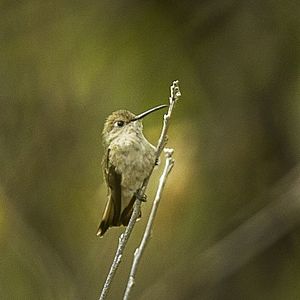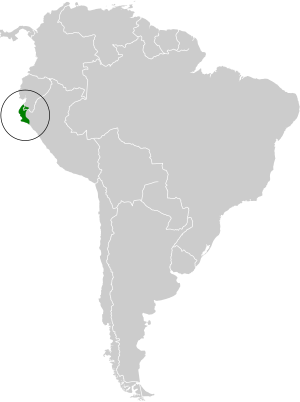Tumbes hummingbird facts for kids
Quick facts for kids Tumbes hummingbird |
|
|---|---|
 |
|
| Conservation status | |
| Scientific classification | |
| Genus: |
Thaumasius
|
| Species: |
baeri
|
 |
|
| Synonyms | |
|
Leucippus baeri |
|
The Tumbes hummingbird (Thaumasius baeri) is a small, fast-flying bird. It belongs to the group of hummingbirds known as "emeralds." You can find this special bird in parts of Ecuador and Peru.
Contents
How Scientists Classify This Bird
Scientists group living things to understand them better. This is called taxonomy. The Tumbes hummingbird used to be in a group called Leucippus. But in 2014, new studies looked closely at the birds' DNA. These studies showed that the Leucippus group wasn't quite right.
To fix this, most scientists moved the Tumbes hummingbird to a different group, or genus, called Thaumasius. The spot-throated hummingbird also moved to this group. So, the Tumbes hummingbird is now usually known as Thaumasius baeri. Some groups, like BirdLife International, still use the old name for now.
The Tumbes hummingbird is also "monotypic." This means it's the only species in its specific group.
What the Tumbes Hummingbird Looks Like
The Tumbes hummingbird is a small bird, about 8 to 11 cm (3.1 to 4.3 in) long. That's about the length of your hand! It weighs around 4.5 g (0.16 oz), which is lighter than a coin.
Both male and female Tumbes hummingbirds look very similar. They have a black bill that is almost straight. Their upper parts, like their back and head, are a pale golden-green color. Their belly and chest are a pale grayish color, turning white on their lower belly.
Their tail feathers are pale green. The feathers closer to their body have bronze tips. The outer tail feathers have a dark gray band near the end. In males, the very tips of these feathers are whitish, while in females, they are grayish.
Where It Lives and Its Home
The Tumbes hummingbird lives in southwestern Ecuador, in areas like El Oro and Loja. It also lives in northwestern Peru, reaching as far south as Lambayeque.
This hummingbird likes dry, bushy areas called arid scrublands. It also lives at the edges of deciduous forests. Deciduous forests are where trees lose their leaves in certain seasons. This area is part of the Tumbes–Piura dry forests region.
You can find these hummingbirds from sea level up to about 1,000 m (3,300 ft) high in Ecuador. In Peru, they can live even higher, up to about 1,275 m (4,200 ft).
Behavior
Movement
The Tumbes hummingbird usually stays in one place. It doesn't travel far. However, it might move a little bit during different seasons.
Feeding Habits
This hummingbird finds its food from the lower to middle parts of plants. It mostly drinks nectar from flowers. We don't know exactly which flowers it likes best. Besides nectar, it also eats small arthropods, which are tiny bugs.
Reproduction
Scientists don't know much about how the Tumbes hummingbird breeds. We don't have descriptions of their nests or when they lay eggs.
Vocalization
The Tumbes hummingbird has a complex song. It sounds like a mix of chirps and "wheezing electric warbles." Its calls are described as a rough "dzee" sound and simple chips.
Conservation Status
The IUCN (International Union for Conservation of Nature) says the Tumbes hummingbird is a species of "Least Concern." This means it's not currently in danger of disappearing.
However, this bird lives in a small area. We don't know how many Tumbes hummingbirds there are or if their numbers are growing or shrinking. No big threats have been found yet. But because they live in a limited space, they could be at risk if their habitat is lost or broken up.
See also
In Spanish: Colibrí de Tumbes para niños


